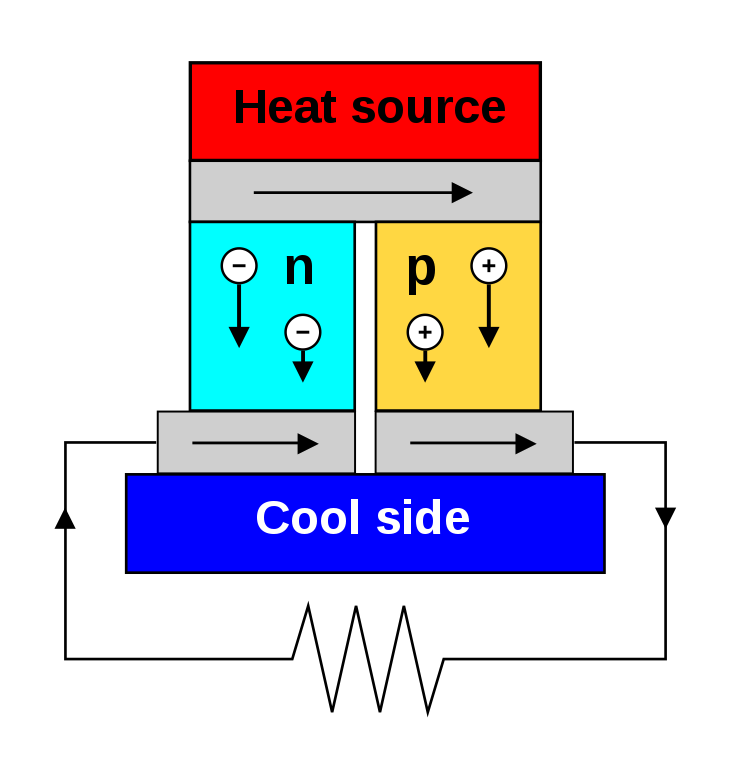Scientists from South Korea have conducted a feasibility analysis for combining thermoelectric generators (TEGs) with heat pumps coupled with photovoltaic-thermal (PVT) systems.
TEGs can convert heat into electricity through the “Seebeck effect,” which occurs when the temperature difference between two different semiconductors produces a voltage difference between two substances. The devices are commonly used for industrial applications to convert excess heat into electricity. However, their high costs and limited performance have thus far limited their adoption on a broader scale.
The researchers said TEGs are critical for achieving zero-energy buildings (ZEBs), although they still do not supply sufficient power for building heating and cooling systems due to low electric generation at present. “Indeed, the ongoing technological advancements in thermoelectric materials are anticipated to yield greater energy recovery potential. Consequently, it is imperative to undertake a comprehensive feasibility assessment concerning the integration and advancement of TEG applications,” they added.
In their work, the researchers sought to harness temperature differences in the inlet and outlet pipes of a heat pump to generate additional electricity. For this purpose, they designed and modeled a hybrid system for a residential house consisting of a PVT with an electric efficiency of 16%, a ground heat exchanger (GHE), and hot storage tank (HST) units.
Modeling
They also modeled a 10.5 kW water-to-water heat pump, with supplementary heating and cooling provided by a fan coil unit. A solar storage tank (SST) was used for additional flow adjustment control. The TEGs were installed on the inlet and the outlet of the PVT, GHE, and HST and had an application of 0.1 m × 1 m in each unit.
“The electric generations of TEG are compared based on conversion efficiency (zT),” the research group explained. “The electrical power generation of TEG produced in each unit was calculated with a zT value of 1. A commercially available thermoelectric element has a zT value of approximately 1, with a conversion efficiency of 10–15%.”
The modeled house was assumed to be located in Seoul, South Korea, and temperatures and solar irradiation were simulated between November and March. The maximum solar radiation during the heating period was 899.7 W/m2, while the daily average solar radiation was 247.7 W/m2.
According to the research team, solar radiation and external temperature significantly impacted the heat exchange rate of the PVT and, therefore, its ability to generate electricity in the TEG. The TEG produced 85 Wh in November, 18 Wh in December, 8 Wh in January, 44 Wh in February, and 196 Wh in March.
Popular content
“During the coldest month of the year, January, the GHE was used to heat the house rather than the circulating water stored in the PVT. Thus, considerably less electricity generation was achieved in January compared to other months, resulting from the limited number of operating days of the PVT and the absence of temperature differences between the inlet and outlet,” they explained.
In contrast, the GHE was able to maintain a constant temperature difference of approximately 4–6 C between the inlet and the outlet, resulting in more stable production. The TEG produced 591 Wh in November, 1,170 Wh in December, 1,389 Wh in January, 1,050 Wh in February, and 675 Wh in March.
For the HST, the water outlet temperature was 42–47 C, while the inlet temperature varied depending on heating demand. This led the TEG to record a generation of 768 Wh in November, 1,309 Wh in December, 1,530 Wh in January, 1,196 Wh in February, and 921 Wh in March.
Feasibility
“In this study, the area of TEG necessary to accomplish a ZEB was estimated,” the researchers said, noting that the heat pump used 10,413 kWh of electricity throughout the heating period, while the PVT produced 3,432 kWh. “Therefore, additional power of 6,980 kWh was needed to accomplish a ZEB, and the installation area of the TEG based on zT was computed for additional power generation. Here, the installation area for the TEG application corresponds to the length of the pipe. When zT was 1, the required TGE installation space in each unit was calculated at 64.5 m2.”
The team concluded that the electricity generation of the TEG applied to the active system was “relatively small,” and a large area was needed to deliver additional power to the heat pump.
The academics said the TEG showed sufficient applicability as a power source for data loggers and other sensors in a building system and are confident that TEGs may be applied further and subsequently reach commercial maturity.
Their findings were presented in the study “Feasibility study on energy harvesting with thermoelectric generators in a photovoltaic-ground source heat pump system,” published on Energy Reports. The group included researchers from South Korea’s Pusan National University and Hanyang University.
This content is protected by copyright and may not be reused. If you want to cooperate with us and would like to reuse some of our content, please contact: editors@pv-magazine.com.


By submitting this form you agree to pv magazine using your data for the purposes of publishing your comment.
Your personal data will only be disclosed or otherwise transmitted to third parties for the purposes of spam filtering or if this is necessary for technical maintenance of the website. Any other transfer to third parties will not take place unless this is justified on the basis of applicable data protection regulations or if pv magazine is legally obliged to do so.
You may revoke this consent at any time with effect for the future, in which case your personal data will be deleted immediately. Otherwise, your data will be deleted if pv magazine has processed your request or the purpose of data storage is fulfilled.
Further information on data privacy can be found in our Data Protection Policy.